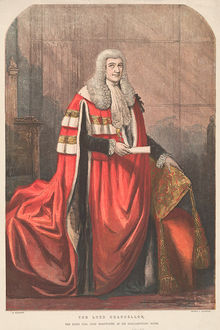British lawyer and Liberal politician Not to be confused with Robert Gurdon, 1st Baron Cranworth.
| The Right HonourableThe Lord CranworthPC | |
|---|---|
 Lord Cranworth wearing the parliamentary robes of a baron Lord Cranworth wearing the parliamentary robes of a baron | |
| Lord High Chancellor of Great Britain | |
| In office 28 December 1852 – 21 February 1858 | |
| Monarch | Victoria |
| Prime Minister | |
| Preceded by | The Lord St Leonards |
| Succeeded by | The Lord Chelmsford |
| In office 7 July 1865 – 26 June 1866 | |
| Monarch | Victoria |
| Prime Minister |
|
| Preceded by | The Lord Westbury |
| Succeeded by | The Lord Chelmsford |
| Personal details | |
| Born | (1790-12-18)18 December 1790 Cranworth, Norfolk |
| Died | 26 July 1868(1868-07-26) (aged 77) Holwood House Keston, Kent United Kingdom |
| Nationality | British |
| Political party | Liberal |
| Alma mater | Trinity College, Cambridge |
Robert Monsey Rolfe, 1st Baron Cranworth, PC (18 December 1790 – 26 July 1868) was a British lawyer and Liberal politician. He twice served as Lord High Chancellor of Great Britain.
Background and education
Born at Cranworth, Norfolk, he was the elder son of the Reverend Edmund Rolfe and Jemima Alexander, James Alexander, 1st Earl of Caledon's niece and a granddaughter of physician Messenger Monsey. Rolfe, a relative of Admiral Lord Horatio Nelson, was educated at Bury St Edmunds, Winchester, Trinity College, Cambridge, Downing College, Cambridge (of which he was elected fellow) and was called to the bar, Lincoln's Inn, in 1816.
Legal and political career
Cranworth represented Penryn and Falmouth in Parliament from 1832 until he was appointed a Baron of the Exchequer in 1839. In 1850 he was appointed a Vice-Chancellor and raised to the peerage as Baron Cranworth, of Cranworth in the County of Norfolk. In 1852 Lord Cranworth became Lord Chancellor in Lord Aberdeen's coalition ministry.
In 1854, Cranworth was appointed to the Royal Commission for Consolidating the Statute Law, a royal commission to consolidate existing statutes and enactments of English law.
Cranworth continued to hold the chancellorship also in the administration of Lord Palmerston until the latter's resignation in 1858. Cranworth was not reappointed when Palmerston returned to office in 1859, but on the retirement of Lord Westbury in 1865 he accepted the office for a second time, and held it till the fall of the Russell administration in 1866.
Personal life
In 1845, Cranworth married Laura Carr (1807–1868), daughter of Thomas William Carr (born 1770). The couple had no children.
Lord Cranworth died at his seat, Holwood House, on 26 July 1868, aged 77, after a short illness related to the heat. He was childless and the title became extinct on his death.
Cases
- Fouldes v. Willoughby (1841)
- Aberdeen Rly Co v Blaikie Bros (1854)
- Scott v Avery (1855)
- Jones v Lock (1865)
- Rylands v. Fletcher judgment given 9 days before his death.
Arms
References
- "Maryland State Archives, Reference, MSA SC 4885-1-27"
- "East Anglian Worthies", by John Lucius Smith-Dampier, published by B. Blackwell, 1949, p. 165.
- ^
 One or more of the preceding sentences incorporates text from a publication now in the public domain: Chisholm, Hugh, ed. (1911). "Cranworth, Robert Monsey Rolfe, Baron". Encyclopædia Britannica. Vol. 7 (11th ed.). Cambridge University Press. p. 379.
One or more of the preceding sentences incorporates text from a publication now in the public domain: Chisholm, Hugh, ed. (1911). "Cranworth, Robert Monsey Rolfe, Baron". Encyclopædia Britannica. Vol. 7 (11th ed.). Cambridge University Press. p. 379.
- Henry Rumsey Forster (1852). The Pocket Peerage of Great Britain and Ireland. D. Bogue. p. 103.
- "Rolfe, Robert Monsey (RLF808RM)". A Cambridge Alumni Database. University of Cambridge.
- Ilbert, Courtenay (1901). Legislative methods and forms. Oxford: Clarendon Press. p. 57. Retrieved 9 September 2024.
- "Lord Cranworth, the last Liberal. Lord Chancellor, died after only » 1 Aug 1868 » The Spectator Archive". The Spectator Archive.
- Burke's Peerage. 1868.
Notes
- Monsey was chief medical adviser to the whigs and a friend of Daniel Dulany the Younger.
External links
- Hansard 1803–2005: contributions in Parliament by Robert Rolfe
- Portraits of Robert Monsey Rolfe, Baron Cranworth at the National Portrait Gallery, London

| Parliament of the United Kingdom | ||
|---|---|---|
| New constituency | Member of Parliament for Penryn and Falmouth 1832–1840 With: Lord Tullamore 1832–1835 James William Freshfield 1835–1840 |
Succeeded byEdward John Hutchins James William Freshfield |
| Legal offices | ||
| Preceded bySir Charles Pepys | Solicitor General 1834 |
Succeeded bySir William Follett |
| Preceded bySir William Follett | Solicitor General 1835–1839 |
Succeeded bySir Thomas Wilde |
| Preceded byJames Wigram | Vice-Chancellor 1850–1851 |
Succeeded bySir George James Turner |
| Political offices | ||
| Preceded byThe Lord St Leonards | Lord High Chancellor of Great Britain 1852–1858 |
Succeeded byThe Lord Chelmsford |
| Preceded byThe Lord Westbury | Lord High Chancellor of Great Britain 1865–1866 |
Succeeded byThe Lord Chelmsford |
| Peerage of the United Kingdom | ||
| New creation | Baron Cranworth 1850–1868 |
Extinct |
- Lord chancellors of Great Britain
- Members of the Parliament of the United Kingdom for Penryn and Falmouth
- Barons in the Peerage of the United Kingdom
- UK MPs 1832–1835
- UK MPs 1835–1837
- UK MPs 1837–1841
- UK MPs who were granted peerages
- 1790 births
- 1868 deaths
- Barons of the Exchequer
- Solicitors general for England and Wales
- People from Breckland District
- Members of the Privy Council of the United Kingdom
- Members of the Judicial Committee of the Privy Council
- Peers of the United Kingdom created by Queen Victoria
- Vice Chancellors (Court of Chancery)


